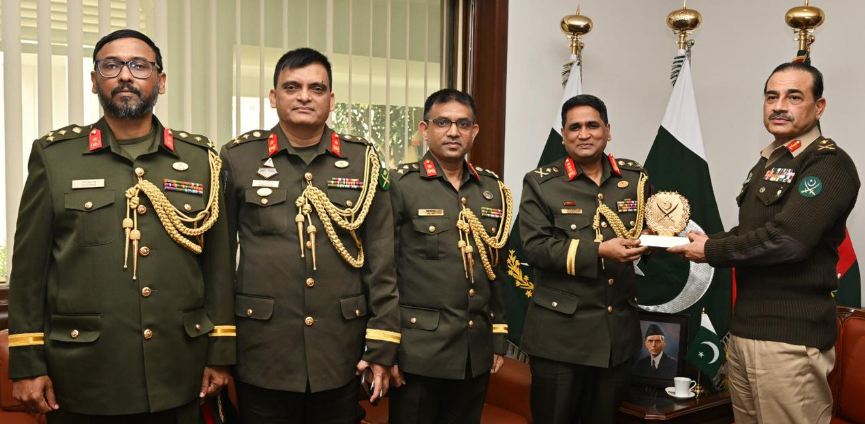by: Muhammad Mohsin Iqbal
After almost half a century, as a student of history, I was struck by a picture that symbolized the transformation of relationships between two nations. The photograph captured Pakistan Army Chief General Syed Asim Munir presenting souvenirs to a top military delegation from Bangladesh, a gesture of goodwill and friendship.This seemingly simple act carried profound symbolism, not just for Pakistan-Bangladesh relations but also for the broader narrative of South Asian history. As I pondered this picture, my mind wandered to another image deeply etched in history; General Amir Abdullah Khan Niazi signing the instrument of surrender at the Racecourse Ground (now Suhrawardy Udyan) in 16 December1971, marking the creation of Bangladesh.

This surrender was not just a military event but a culmination of years of political unrest, misunderstandings, and external conspiracies. It symbolized the tragic breakdown of unity within Pakistan and the birth of a new nation under circumstances marred by international intrigue. For years, this image adorned the walls of Bangladesh’s political elite. It served as a constant reminder of their liberation struggle and, at times, a tool for fostering animosity against Pakistan. A notable example was the placement of the surrender photograph in the Bangladeshi Prime Minister’s office, where Sheikh Hasina Wajid would often stand with Indian Prime Minister Narendra Modi for media coverage, emphasizing the bond between India and Bangladesh that was forged during those turbulent times.
However, history has a way of revealing hidden truths. Over time, the Indian narrative of its role in the 1971 war has been openly acknowledged by Indian leadership. Prime Minister Modi himself has repeatedly boasted about India’s involvement in the dismemberment of Pakistan. His admission aligns with documented evidence of India’s covert operations, military interventions, and support for the Mukti Bahini. This acknowledgment, while a point of pride for India, has also served to expose its role in exploiting regional vulnerabilities for its own geopolitical ambitions.
For decades, Bangladesh appeared ensnared in India’s strategic orbit, with economic and political ties heavily skewed in India’s favor. Indian goods dominated Bangladeshi markets, water-sharing disputes over transboundary rivers remained unresolved, and Indian influence often seemed to encroach upon Bangladesh’s sovereignty. However, in recent years, as relations have shown signs of strain, Bangladesh has begun to assert its independence at the regional level.
In this evolving context, the recent thaw in Pakistan-Bangladesh relations is a development of immense significance. The symbolic meeting between General Syed Asim Munir and the Bangladeshi military delegation represents a conscious effort to move beyond the bitter legacy of 1971. Both nations appear to recognize the futility of prolonged hostility and the benefits of fostering brotherhood. This rapprochement is rooted not just in shared history and culture but also in pragmatic considerations. In a region dominated by India’s hegemonic ambitions, cooperation between Pakistan and Bangladesh could serve as a counterbalance, ensuring greater regional stability.
The economic trajectories of both nations further underscore the need for collaboration. Bangladesh has emerged as a global leader in textile exports, achieving remarkable economic growth despite challenges. Pakistan, with its vast resources and strategic location, has the potential to complement Bangladesh’s economic aspirations. Trade agreements, joint ventures, and cultural exchanges could unlock untapped potential, benefiting both nations.
Moreover, the shared religious and cultural heritage between Pakistan and Bangladesh remains a powerful bridge. Despite the painful separation, the bonds of faith, language, and traditions have endured. Initiatives such as academic exchanges, people-to-people contact, and collaboration in arts and sports can further cement these ties.
The broader geopolitical landscape also necessitates unity. India’s expansionist policies and its attempts to isolate Pakistan have not gone unnoticed. The same India that once posed as Bangladesh’s liberator has now been unmasked as a regional bully, manipulating its neighbors to serve its own interests. By strengthening their bilateral relationship, Pakistan and Bangladesh can collectively challenge this narrative, advocating for a more inclusive and balanced South Asia.
This renewed brotherhood also reflects the resilience of nations and their ability to overcome historical grievances. It is a testament to the enduring truth that no external power can permanently divide those united by shared destiny. The journey from 1971 to the present moment has been fraught with challenges, but it also demonstrates the capacity for reconciliation and forward-thinking leadership.
As I revisited the image of General Niazi’s surrender, juxtaposed with the recent picture of General Asim Munir extending goodwill, a poignant Urdu verse came to mind: “Pohnchiwahan pay khak,jahan ka khameertha” (Destiny ultimately leads us to where we truly belong). The wheel of time has turned, exposing conspiracies and unveiling new realities. The past, though painful, serves as a guide for the future. It reminds us that while history cannot be undone, it can be a source of learning and growth.
The evolving Pakistan-Bangladesh relationship holds lessons for all nations grappling with the weight of historical animosities. It underscores the importance of dialogue, mutual respect, and the recognition of shared interests. As the region stands at a crossroads, the example set by these two nations could inspire a new era of cooperation and harmony in South Asia, defying the divisive forces that once tore them apart.











